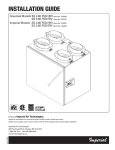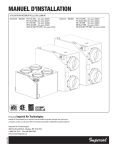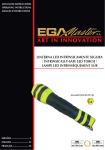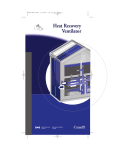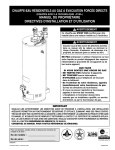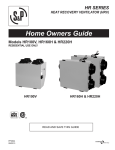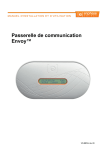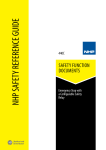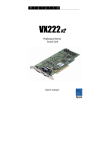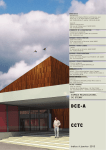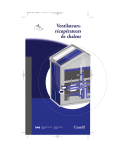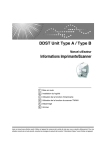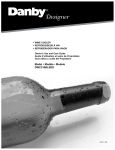Download INSTALLATION GUIDE - Imperial Manufacturing Group
Transcript
InstallatIon GuIde RESIDENTIAl uSE oNly Greentek Models SS 3.80 FSD HRV SS 3.80 FSD ERV (Item No. 102208) (Item No. 102210) Imperial Models SS 3.80 FSD HRV SS 3.80 FSD ERV Product of Imperial Air Technologies Imperial Air technologies Inc. reserves the rights to modify a product, without prior notice, whether in price, design, color or codes, in order to offer at all times quality products that are highly competitive. Item# 102337 Imperial Air Technologies 480 Ferdinand Blvd., Dieppe, NB E1A 6V9 1-888-724-5211 Fax 506 388-4633 www.imperialgroup.ca (Item No. 102257) (Item No. 102259) ImPorTAnT - PleAse reAd mAnuAl before InsTAllATIon CAuTIon: Do not install in a cooking area or connect directly to any appliance. Turn off all integral disconnects before servicing. noTICe: Prior to installing, serious consideration must be taken to insure this ventilation system will operate properly if integrated to any other type of mechanical system, i.e. a forced air system, or an air handling unit. To insure proper operation & compatibilities of both system, it is required that the airflow’s of the Heat Recovery Ventilator (HRV) or Energy Recovery Ventilator (ERV) be balanced, by following the procedures found in this manual. lImITATIons: The product is for residential applications only. Must be installed in accordance with all national and local regulations, building and safety codes. To reduCe or AvoId The hAzArds of eleCTrIC shoCk And fIre: CAuTIons ConCernIng The oPerATIon And full effICIenCy of ThIs ProduCT: • Before servicing or cleaning the HRV system, always remove the power cord from the AC wall outlet. • To reduce the hazards of electric shock or fire, do not perform any service to the HRV system other than those stated in the operating manual instructions. • Toreducetheriskofelectricshock,thisventilationsystem(HRV/ERV) comes equipped with a 3-prong plug-in. This plug will fit in a polarized outlet only one way. • Donotuseventilationsystemforoutdoorapplication. • Do not pull or twist power cord when disconnecting it from the ventilation system. Grasp the plug firmly, not the cord. • Donotmodifythepowerpluginanyway;ifmodified,riskofelectric shock fire or even damage to the unit may occur. • Do not use the ventilation system for removal of flammable fumes, gases or connect directly to any appliances. • UseadedicatedAC120Voutletonly. • Donotobstructorcovertheairintakeorairoutletoftheventilation system. • Donotmodify,repairordisassemblethissystem.Thesetasksareto be performed by authorized serviced personnel only. Fire, electrical shock and/or bodily injury may occur if these warnings are not followed. • To prevent injuries, do not operate the ventilation system, while servicing or maintaining. There are impeller wheels turning at a very high speed that must fully stop rotating prior to accessing the inside of the unit. • Alwaysassesstheoperationoftheventilationsystemonhowitmay interact with vented combustion equipment (ie. Gas Furnace, Oil Furnace, Combustion, Appliances, etc.) • Donotuseforswimmingpool/spaapplications. AbouT us Imperial Air Technologies Inc. is the only manufacturer that offers you a complete range of products designed to improve indoor air quality, and that provides a wide selection of accessories to facilitate installation. Our vision – To offer a complete range of products that satisfies environmental concerns. Whether your needs involve ventilation or filtration, we have the customized solution for you, with its range of quality products backed by the best warranty in the industry. ConTenTs seCTIon 1. Ventilation requirements . . . . . . . . . . . . . . . . 2. Fitting equivalent lengths . . . . . . . . . . . . . . . . 3. Types of Installations . . . . . . . . . . . . . . . . . . 4. Installation Kit. . . . . . . . . . . . . . . . . . . . . . . 5. Finding a suitable installation area for HRV or ERV . 6. Installation of the HRV / ERV . . . . . . . . . . . . . . 7. Insulated Flex from Unit to Outside Wall . . . . . . . 8. Condensation Drain Line . . . . . . . . . . . . . . . . 9. Dedicated Electric Receptacle . . . . . . . . . . . . . 10. Outside Fresh Air and Exhaust Air Hoods . . . . . . 11. The matrix™ High Performance Ventilation Hood . 12. Benefits of the Duotrol™ System. . . . . . . . . . . 13. Balancing the unit . . . . . . . . . . . . . . . . . . . . 14. Controls Connection . . . . . . . . . . . . . . . . . . 15. Wiring Diagrams for furnace interlock systems . . 16. Troubleshooting . . . . . . . . . . . . . . . . . . . . . 17. Maintenance . . . . . . . . . . . . . . . . . . . . . . . Page 2 . . . . . . . . . . . . . . . . . . . . . . . . . . . . . . . . . . . . . . . . . . . . . . . . . . . . . . . . . . . . . . . . . . . . . . . . . . . . . . . . . . . . . . . . . . . . . . . . . . . . . . . . . . . . . . . . . . . . . . . PAge . . 3 . . 4 . . 5 . . 7 . . 7 . . 7 . . 8 . . 8 . . 8 . . 9 . . 9 . . 10 . . 10 . . 12 . . 13 . . 14 . . 15 1. venTIlATIon requIremenTs deTermIne your venTIlATIon needs InsTAllATIon A. room Count Calculation lIvIng sPACe Master Bedroom number of rooms Cfm (l/s) Cfm requIred ———— x 20 cfm (10 L/s) = ———— How much fresh air do I need? Good air quality is based in part on the capacity of the home’s ventilation system. With Basement ———— x 20 cfm (10 L/s) = ———— Single Bedroom ———— x 10 cfm (5 L/s) = ———— Living Room ———— x 10 cfm (5 L/s) = ———— Usually, the HRV’s/ERV’s capacity is measured in CFM (Cubic Feet per Minutes) or L/s (Liters per Seconds) of fresh air being distributed in the living space. The Room Count Calculation or the Air Change per Hour Method shows you how to determine your ventilation needs. (see chart on right) Dinning Room ———— x 10 cfm (5 L/s) = ———— Family Room ———— x 10 cfm (5 L/s) = ———— Recreation Room ———— x 10 cfm (5 L/s) = ———— Other ———— x 10 cfm (5 L/s) = ———— Kitchen ———— x 10 cfm (5 L/s) = ———— Bathroom ———— x 10 cfm (5 L/s) = ———— Laundry Room ———— x 10 cfm (5 L/s) = ———— Utility Room ———— x 10 cfm (5 L/s) = ———— ToTAl ventilation requirement (add last column) = ———— 1 CFM = 0.47189 L/s 1 L/s = 3.6 m3/hr b. Air Change per hour method TOTAL cu ft X 0.35 per hr = total Take total and divide by 60 to get CFM example: A 25’x 40’ house with basement 1,000 Sq. ft. x 8’ high x 2(1st floor + basement) = 16,000 cu. ft. 16,000 cu. ft. x 0.35 ACH = 5,600 cu. ft. 5,600 cu. ft. / 60 Minutes = 93.3 CFM 93.3 Cfm Is your venTIlATIon need Page 3 2. fITTIng equIvAlenT lengThs - Flex pipe equivalent length is smooth pipe x2 - Flex fitting equivalent length is smooth fitting x2 - 90º perimeter pipe elbow equivalent length = 10 ft. (3.0 m) noTe: Where flex duct is used to make 90º elbow equivalent length = 20 ft. (6.1 m) noTe: Where flex duct is used to make 45º elbow equivalent length = 10 ft. (3.0 m) - Round wall cap spring damper or screen equivalent lengths = 60 ft. (18.29 m) - Y-equal sides equivalent length = 10 ft. (3.0 m) - Y-Side branch equivalent length = 35 ft. (10.7 m) - Angle boot equivalent length = 30 ft. (9.14 m) - Tee take-off equivalent length = 50 ft. (15.24 m) - Wall grill 50% free area equivalent length = 15 ft. (4.6 m) - Increaser/Reducer equivalent length = 8 ft. (2.43 m) - Round plastic diffuser equivalent length = 100 ft. (30.5 m) noTe: Maximum airflow assumes diffuser is in full open position. Page 4 - 45º perimeter pipe elbow equivalent length = 5 ft. (1.52 m) 3. TyPes of InsTAllATIons IndePendenT sysTem InsTAllATIon figure 3.1 This application uses a devoted duct system for the supply and the exhausting of stale air accumulated in the home. It is recommended to install fresh air grilles in all bedrooms and living areas. Exhaust the stale air from the bathroom, kitchen and laundry room. (see figure 3.1) ImPorTAnT: For optimal performance of your HRV or ERV, the installation of an optional 6” round galvanized backdraft damper is required on the fresh air to home duct work. exhAusT AT The sourCe And suPPly In The reTurn This application uses a devoted duct system for the exhausting of stale air accumulated in the home. The fresh air is dumped into the return air duct and is distributed thru the home by the existing supply air ductwork of the forced air system. (see figure 3.2) Make sure when using this application that your fresh air duct connection to the forced air system return air duct is not less than 10ft (3 m) upstream of the return plenum connection to the forced air system. Check with your local code or the forced air system’s manufacturer. The HRV and forced air system must be in continuous mode, to achieve maximum comfort and to avoid cross-contamination. noTe To InsTAller: Dwellings with multiple forced air systems requires one HRV/ERV per system. figure 3.2 From Bathroom or Kitchen To living space A 6' (1.83 m) b 18" (457 mm) HRV / ERV Forced Air System A+b=noT less ThAn 10fT (3 m)* ImPorTAnT: The duct bringing outdoor air to the return air plenum must be equipped with a manual dumper to balance the outdoor airflow. * For minimum distance between return and forced air system, check with your local building codes and forced air system manufacturer. Insure the unit runs in conjunction with forced air system (Ref. wiring diagram for furnace interlock) ImPorTAnT: For optimal performance of your HRV or ERV, the installation of an optional 6" round galvanized backdraft damper is required on the fresh air to home duct work. When performing duct connections, always use approved tools and material. Also use steel duct connections for these type of installs. Page 5 3. TyPes of InsTAllATIons (COnTInUED) exhAusT And suPPly In The reTurn figure 3.3 A When using this application make sure that there is minimum 3 feet (0.9 m)between the fresh air and exhaust air connections of the HRV/ERV in the return air duct. (see figure 3.3) Make sure when using this application that your fresh air duct connection to the forced air system return air duct is not less than 10ft (3 m) upstream of the return plenum connection to the forced air system. Check with your local code or the forced air system’s manufacturer. The HRV and forced air system must be in continuous mode, to achieve maximum comfort and to avoid cross-contamination. noTe To InsTAller: Dwellings with multiple forced air systems requires one HRV/ERV per system. Insure the unit runs in conjunction with forced air system (Ref. wiring diagram for furnace interlock) 6' (1.83 m) To living space b 18" (457 mm) 3ft (0.9 m) mInImum dIsTAnCe HRV / ERV Forced Air System A+b=noT less ThAn 10fT (3 m)* * For minimum distance between return and forced air system, check with your local building codes and forced air system manufacturer. ImPorTAnT: The duct bringing outdoor air to the return air plenum must be equipped with a manual dumper to balance the outdoor airflow. Simplified Connection ImPorTAnT: Building and combustion appliance installation codes do not allow return air grilles or openings such as "breather tee" or indirect connections in an enclosed room that is susceptible to spillage of combustion appliances. Indirect Connection Breather Tee 2" (51 cm) ImPorTAnT: For optimal performance of your HRV or ERV, the installation of an optional 6" round galvanized backdraft damper is required on the fresh air to home duct work. When performing duct connections, always use approved tools and material. Also use steel duct connections for these type of installs. Page 6 4. InsTAllATIon kIT InCluded In The InsTAllATIon kIT: figure 4.1 •4Collars •4Caps,PressureTaps(9753K74) •1CondensationDrainLine •1DrainAdapterwithNut •12screws(#10x11/4”) •2screws(#8x3/8”) •AC120Vpowercord •WallMountingBracket 5. fIndIng A suITAble InsTAllATIon AreA for hrv or erv The HRV/ERV unit should be installed in a mechanical room or as close to an outside wall as possible. This would assure a short run of insulated flexible duct. The HRV/ERV unit must always be installed in an area where the air is tempered to avoid freezing of the condensate line. The contractor should install the unit in an area that is very accessible to allow the homeowner easy access for maintenance. It is very important to install an electric receptacle (115v) near the HRV / ERV, a separate circuit breaker is also recommended. You should have access to a condensate drain near the HRV/ERV to avoid the use of condensate pump. 6. InsTAllATIon of The hrv / erv ImPorTAnT Minimum installation requirements A) Minimum two 2"x 4" (50.8 mm x 101.6 mm) wood wall studs and minimum 3⁄8 " (9.5 mm) thick drywall is required to secure the HRV/ERV wall bracket. b) Support for weight of 80 lbs, which includes HRV/ERV, duct connections and accessories. Proper installation requires that the unit be secure to the wall. If there is no wall studs available, please secure a 3 ⁄4" plywood to wall studs then fasten wall mounting bracket to plywood. figure 6.1 Installation of the wall bracket. Secure with two #10 x 11⁄4" screws. TIP To InsTAller: If the unit is not level, improper drainage will occur and could lead to moisture and leakage problems. It is recommended to use approximately 16 inches of flexible duct between the HRV/ERV and your rigid duct. The flex duct is mounted the same way to the HRV/ ERV as the insulated flex. figure 6.2 Hang HRV/ERV to wall mounting bracket. figure 6.3 When completing the procedure make sure that the HRV/ERV is leveled. figure 6.4 Proceed to secure HRV/ERV to bracket with the two #8 x 3⁄8 " screws. Page 7 7. InsulATed flex from unIT To ouTsIde WAll TIP To InsTAller: To ensure a better installation and to avoid an undesired bend in the duct, align the duct with the collar before securing over the four hooks. WArnIng: Always fix and secure the 5" collars with the screws supplied. Avoiding this critical step the unit will figure 7.1 Insert vinyl duct over the hooks accumulate condensation. and seal with a Tie wrap. figure 7.2 Insert insulation inside the collar. figure 7.3 Finish by taping the duct on the collar. Once insulated flex is attached to the collar, slide collar in keeper section, fixed collar to the unit with four screws supplied in installation kit. figure 7.4 Slide collar on the unit. Figure 7.5 Fix and secure the collars to the HRV/ ERV with the #10 x 11⁄4" screws, supplied in kit. 8. CondensATIon drAIn lIne Insert the threaded drain adapter thru the bottom of the HRV/ERV and hand tighten the plastic nut, and with a wrench tighten the nut another half turn to assure a better seal. Install the condensate line (included in drain kit). Insert condensate tubing by pushing clear plastic line over drain adapter. Make condensate trap by looping the clear plastic tubing. This procedure is to avoid foul odor to enter the HRV or ERV. figure 8.1 Make a loop in condensate line, not be subject to freezing temperatures. 9. dedICATed eleCTrIC reCePTACle ImPorTAnT: Always consult a certified technician to insure proper installation of main power. noTe: If LED light on the Duotrol remains green, motors not energized controls do not operate. Polarization in main AC outlet are inverted. It is recommended that the HRV/ ERV have a dedicated receptacle with 115v. It is not recommended to connect unit with an extension cord. Page 8 figure 9.1 Insert the power cord on top of the unit. Press firmly to make sure the power cord is secure. figure 8.2 Use a condensate pump if you don’t have access to a drain. 10. ouTsIde fresh AIr And exhAusT AIr hoods TIP To InsTAller: We recommend and it is good practice to have a minimum of 6ft (1.83 m) between the supply and exhaust vents, unless using a concentric vent design to prevent contamination of intake air. 6ft (1.83 m) noTe: Outdoor air intake hoods shall be located to avoid contamination from sources such as: •Exhaustairopenings •Driveways(autoexhaust) 18" (457 mm) •Combustionappliances •Gasmeters,oilfillpipes •Garbagecontainers •Atticsorcrawlspaces •Under deck or other areas of questionable air quality figure 10.1 Locating Outside Hoods ImPorTAnT: Always consult your national and local regulations, building and safety codes. 11. The mATrIx™ HIGH PERFORMAnCE VEnTILATIOn HOOD AIrfloW & InsTAllATIon Exterior wall Exhaust air from home “TOP” ImPorTAnT: Install ventilation hood a minimum of 18” (457mm) above grade. Do not install under a deck, enclose porch, patio, garages, crawl spaces or attics. Fresh air to home “BOTTOM” WArnIng: Insure the ventilation hood is at a minimum clearance of 6 ft (1.83 m) away from the exhaust vents of a combustion source and contaminants. Exhaust air to outside Ex: Gas furnace, dryer, gas boilers, range hoods, barbecue, garbage bin, driveway or garage. Ventilation cap Uniquely design individual insulated transition duct (UL 94 Rated) Transition connector plate ImPorTAnT: Always consult national and your local regulations, building and safety codes. lImITATIon: This product is for residential applications only. Fresh air from outside Airflow Performance Data Supply Air Flow Performance 0.25 External Static Pressure in wg (Pa = n x 248.36) lImITATIons: This product is for residential applications only. Must be installed in accordance with all current national and local regulation building and safety codes. Exhaust Air Flow Performance 0.25 External Static Pressure in wg (Pa = n x 248.36) AIrfloW PerformAnCe dATA 0.2 0.15 0.1 0.05 0 30 45 60 75 90 CFM (L/s = n x 0.4719) 105 120 0.2 0.15 0.1 0.05 0 30 45 60 75 90 105 120 CFM (L/s = n x 0.4719) Limitations: This product is for residential applications only. Must be installed in accordance with all current national and local regulation building and safetyPage codes. 9 12. benefITs of The duoTrol™ sysTem mode seleCTor ACTs As A mode seleCTor •Intermittent InTermITTenT: When the selector switch is in the intermittent position the HRV/ERV will only run when there is a call for ventilation by any control. At that time the unit will run on high speed until the condition is satisfied. •Continuous •Off ConTInuous: When the selector switch is in the continuous position the HRV/ERV will run continuously on pre set speed except when there is a call for override by any control. off: When the selector switch is in the off position the HRV/ERV will not come on even if there’s a call for ventilation by any control. sPeed AdjusTmenT + buTTon: Increase the speed of the selected motor. •IncreaseSpeed(+) – buTTon: Decrease the speed of the selected motor. •DecreaseSpeed( – ) 13. bAlAnCIng The unIT WITh The duoTrol™ sysTem GREEn LIGHT MODE SELECTOR usIng The seleCTor sWITCh TIP To InsTAller: When on Balancing Mode, the Selector Switch allows you to choose the motor you want to set. A) Closed duoTrol Cover b) oPen duoTrol Cover 1. InTer (Exhaust Motor) 1. uP (Exhaust Motor) 2. ConT (Both Motors) 2. mIddle (Both Motors) 3. off (Supply Motor) 3. doWn (Supply Motor) duoTrolTm bAlAnCIng sysTem YELLOW LIGHT BALAnCInG MODE ProCedures, sTePs 1 Through 8. Page 10 step 1: Press the (+) and (–) buttons simultaneously until you see the yellow light. Once the indicator light turns yellow you are in balancing mode. step 5: Then perform the same operation on the stale air side by selecting the «InTER» position on the DuotrolTM. step 2: When in balancing mode the selector switch becomes the motor selector switch. InTER (Right Motor), COnT (Both Motors) and OFF (Left Motor) step 6: The «COnT» position will allow you to adjust the cfm on both motors proportionately (if necessary). step 3: Once the total cfm needed is determined, you can start balancing the HRV/ERV. Set your fresh air supply by selecting the «OFF» position on the Duotrol TM. Install your magnehelic gauge and air flow grid in the fresh air duct. step 7: Once this is completed, you have set the high speed on your HRV/ERV. To lock balancing mode you must press (+) and (–) buttons simultaneously and release. The indicator light will turn green to indicate normal operation mode. step 4: Press the (–) button to decrease the cfm or press the (+) button to increase the cfm. step 8: Once high speed is set and locked, switch to continuous on the Duotrol TM. By using (+) and (-) buttons set low speed on the HRV/ERV. 13 bAlAnCIng The unIT (COnTInUED) WITh The duoTrol sysTem And The InTegrATed bAlAnCIng TAPs And mAgnehelIC gAuge. HIGH (Exhaust Air to Outside) LOW (Exhaust Air from Home) Magnehelic gauge Balancing Tap Connection* Magnehelic gauge HIGH (Fresh Air to home) LOW (Fresh Air from Outside) Connecting the Magnehelic gauge to the collar balacing taps, then proceed to section 13 (on page 10) Duotrol TM Balancing System Procedures and follow the Steps 1 through Step 8. bAlAnCIng ChArT The balancing chart is based on a Delta P (DP) measurement (also located on the access panel of the ventilation system) noTe: To perform a proper install, the External Static Pressure (ESP) needs to be measured at each of the 4 stations. Then proceed to measure the Delta P(DP) to determine the corresponding airflow (e.g. 50 CFM), then do the iteration until the unit is balanced both the (ESP and airflows). Balancing Chart when using collar pressure taps. Pressure Pa 50 62 75 87 100 112 125 137 150 162 175 187 199 Fresh Air in. wg 0.20 0.25 0.30 0.35 0.40 0.45 0.50 0.55 0.60 0.65 0.70 0.75 0.80 L/s 44 41 39 37 35 33 30 29 26 24 22 19 17 Exhaust Air CFM 93 87 83 79 74 69 65 61 56 50 46 41 36 L/s 43 40 37 36 36 34 32 28 24 22 19 17 15 CFM 90 85 79 77 76 71 67 60 51 47 41 36 31 *ImPorTAnT: Once balancing is complete, insure all four pressure taps are sealed with the rubber caps. Pressure taps (9753K74) supplied in the installation kit. WITh An AIrfloW grId & mAgnehelIC gAuge Magnehelic Gauge with Air Flow Grid Inserting Air flow grid in duct Seal Air flow grid in duct with duct tape. Page 11 14. ConTrols ConneCTIon rd-1 (2 wires) G G R R rd-2, rd-3P, rd-4P (4 wires) R R G G B B W W B B G G R R Jumper Jumper JP-4* JP-4* LVC LVC Version Version 1 1 2 2 Relays Relays R RW W B B G G To To Casing Casing Screw Screw for Ground Ground for Jumper Jumper JP-4* JP-4* LVC LVC Version Version 2 2 CAuTIon: Minimum wire requirements is LVT18 CSA/UL 4 strain to insure proper connection. Page 12 1 1 Relay Relay 15. WIrIng dIAgrAms for furnACe InTerloCk sysTems sTAndArd forCed AIr InTerloCkIng WIrIng A relay is normally used when tying a ventilation system to the forced air distribution system. Our Duotrol System is equipped with an internal relay that will activate the forced air system’ ventilator when there is a demand from the HRV /ERV. The Duotrol System will activate the InTERLOCK relay during the following modes: Continuous, Override,Recirculation and Defrost. See wiring diagram. Low Voltage HRV Controller Force Air System legend: -------- Field Installed Low Voltage Figure 15.1 Standard forced air wiring diagram AlTernATe forCed AIr InTerloCkIng WIrIng Some forced air system thermostat will activate the cooling system when tied using the «Standard forced air interlocking wiring». If you have identify this type of thermostat you must proceed with the «Alternate Forced Air Wiring». loCATIng The WIrIng dIAgrAm noTe To InsTAller: Wiring Diagram for the entire line of HRV/ERV Models are placed on the back of each Exhaust motor bracket. CAuTIon: Thermostat that control A/C system must use the Alternate Interlock Wiring Diagram. Force Air System Low Voltage HRV Controller *Before tying the HRV/ERV to a forced air system, always refer to system’s manual or manufacturer. Thermostat legend: -------- Field Installed Low Voltage Figure 15.2 Alternate forced air wiring diagram WArnIng: Always disconnect the unit prior to making any connections. Failure to disconnecting the power could result in electrical shock or can damage the electronic boards, wall controls and/or unit. CAuTIon: Minimum wire requirements is LVT18 CSA/UL 4 strain to insure proper connection. Page 13 16. TroubleshooTIng quesTIon / ITem dIAgnosIs / soluTIon •HRV/ERVnotrunning • Verifybreakerinmainelectricalpanel • VerifytheHRVorERVisintheONposition • VerifytheallwallcontrolsswitchontheHRVorERVareactivatedtosupplypowertotheunit • UnplugHRVorERVverifyifthecontrolleriswiredcorrectlytotheconnectionboxonthesideoftheunit • Verifymainoutletpolarization •Airistoodry • Reducethehumiditylevelonthecontroller • Reducecontinuousairflowrate • Switchventilationmodefromcontinuoustointermittent • Humidifierrecommendedifheatingsourceisaforcedairsystem •Airtoohumid • SuggestcontinuousoperationofHRVorERV • Increasehumiditylevelondehumidistat • Increasecontinuousairflowrate • Insufficientventilation,checkcapacity • Internalsourceofmoisture,e.g.heatingwoodstoreinbasement,possibleleaksorpoorinsulationR-valueandor dryer is venting in basement •Vibrationornoise • Verifythatvibrationmountingstraps,hangingchainsorwallbracketisusedforhangingtheunits. • VerifythatflexibleductconnectionsareusebetweentheHRVorERVandtherigidduct. • Verifythatthemotorsareoperatingandarenotobscuredbyanydebris • Insuremotormovesfreelywithturningbyhand. •Coldair • Misplacedsupplyoutlets • Defrostnooperatingcorrectly • TheHRVorERVnotproperlybalanced • Highairflowonfurnacecontinuousmode • InsureHRVorERVisinterlockwhenintegratedwithforcedairsystem •ContaminationorPollutants • Insureproperclearanceofventilationhoodsfromsourceofcontaminants Refer to section 10. Outside Fresh Air and Exhaust Air Hoods. •Condensation • VerifythattheHRVorERVisleveltoinsureproperdrainage • VerifythattheductconnectionarefixandsecuredwithscrewstotheHRVorERV. • Verifythecoldsideductconnectionsarefullyinsulatedandthatvaporbarrieristapedtoinsureaproperseal. • Lookforsignsofcrushedsection,failingductstraps,puncturevaporbarrier,missinginsulation. • Insurepropersealofvaporbarriertooutsidewall. • Lookforsignofwateraccumulation/leakage/dripping • Verifythatthedrainconnectionisnotkinked;the“P”trapisnottoclosetounitorobscuredwithdebris. Page 14 17. mAInTenAnCe rouTIne mAInTenAnCe seven-sTeP mAInTenAnCe sChedule With routine preventative maintenance, you can avoid unnecessary problems, ensure the effectiveness of your HRV, and prolong its life. For additional specific instructions, refer to your HRV operating manual or ask the contractor who installed or services the HRV to demonstrate the proper maintenance procedures. WArnIng: BE SURE TO DISCOnnECT THE ELECTRICAL POWER BEFORE SERVICInG YOUR SYSTEM 1. Clean or replace air filters. Filters, which are located within the HRV should be cleaned every two to three months. Filters should be vacuumed first, then washed with a mild soap and water. Most washable filters will last several years before needing to be replaced. 2. Clean the exterior intake and exhaust vents of obstructions.Check the outside vents regularly to ensure that the screen openings are not obstructed by grass, bushes, leaves, snow or other debris. 3. Clean and inspect the heat-exchange core and aluminum louvers (Ref. Fig. 17.1 for proper orientation of louvers). Twice a year and clean it as required (consult your owner’s manual for instructions on inspecting and cleaning the core). A build-up of dust and dirt can restrict airflow and reduce the efficiency of your HRV/ERV. After inspection and cleaning, make sure the core is replaced right-side-up. 4. Clean the condensate drain and pan. Twice a year, check the condensate drain and tubing to ensure that they are open and free-flowing. The tubing can be disconnected for cleaning. The condensate drain must havea“trap”inthetubingthattraps a quantity of water – to prevent air from entering the HRV/ERV via this tubing 5. Service the fans. The fans on the HRV/ERV’s are designed to operate continuously without lubrication. Inspect the blower fans periodically for dirt on the blades, and remove it by gently brushing the blades or using a vacuum cleaner. 6. Clean the grilles and inspect the ductwork. Clean the grilles when they are dusty. At least once a year, visually inspect the ductwork leading to and from the HRV. Damaged ducts can lead to condensation problems, including wet insulation, water on the floor and, ice build-up. If the insulation itself is damaged. 7. Arrange for an annual servicing. Your HRV/ERV should undergo annual general servicing by a certified contractor and who is familiar with your HRV. If possible, have your furnace and HRV serviced atthesametime;thiswillresultin less inconvenience and cost than two separate visits. All Imperial Air Technologies products are backed by the best limited warranty on the market. Imperial Air technologies Inc. reserves the rights to modify a product, without prior notice, whether in price, design, color or codes, in order to offer at all times quality products that are highly competitive. AlWAys ConsulT your nATIonAl And loCAl regulATIons buIldIng And sAfeTy Codes. Page 15 Item# 102337 Imperial Air Technologies 480 Ferdinand Blvd., Dieppe, NB E1A 6V9 1-888-724-5211 Fax 506 388-4633 www.imperialgroup.ca Item# 102337 Imperial Air Technologies 480 Ferdinand Blvd., Dieppe, NB E1A 6V9 1-888-724-5211 Fax 506 388-4633 www.imperialgroup.ca 17. ENTRETIEN HORAIRE D'ENTRETIEN Avec un entretien préventif régulier, vous pouvez éviter les problèmes inutiles, assurer l'efficacité de votre VRC/VRE et prolonger sa durée de vie. Pour obtenir des instructions supplémentaires, consultez le manuel d'installation de votre système ou demandez à l'entrepreneur qu’il vous démontre les procédures d'entretien. AVERTISSEMENT: TOUJOURSDEBRANCHERTOUT APPAREIL ELECTRIQUE AVANT L’ENTRETIEN. 1. Nettoyez ou remplacez les filtres. Les filtres, qui sont situés dans le VRC/VRE doivent être nettoyés. Nettoyer les filtres régulièrement soit tous les deux à trois mois ou selon le besoin à l'aide d'un aspirateur en premier et rincé a l’eau tiède. Remplacer selon le besoin. 2. Vérifiez les évents muraux à l'extérieur régulièrement pour s'assurer que les ouvertures sont pas obstruées par l'herbe, feuilles, neige ou autres déchets quel compte. 3. Nettoyer le noyau d'échange. Inspecter le noyau d'échange et les plaques de distribution d’air (Fig 17.1) deux fois par ans. Nettoyer selon le besoin (consultez votre manuel d’installation et les instructions qui sont identifiés sur le noyau d’échange suivre les étapes de nettoyage) Une accumulation de poussière et la saleté peut réduire la circulation de l'air et réduire l'efficacité de votre VRC/VRE. Après l'inspection et le nettoyage, assurezvous que le noyau est remplacé selon les instructions. 4. Nettoyer le drain de condensation et le bac. Deux fois ans, vérifiez le drain de condensation pour s'assurer qu'il n’est pas obstrué et que la condensation écoule librement. Le conduit du drain peut être débranché pour le nettoyage. Le drain de condensation doit avoir un « siphon » pour empêcher les odeurs de pénétrer dans le VRC/VRE. 5. Les ventilateurs sont lubrifiés à vie et nécessitent aucun entretien. Inspecter les lames du ventilateur périodiquement à l'aide d'un aspirateur ou une brosse supprimer la saleté doucement. 6. Nettoyer les grilles et inspectez les conduits. Nettoyer les grilles lorsqu'ils sont poussiéreuse. Au moins une fois par an, inspecter visuellement les conduits menant vers et à partir du VRC/VRE. Des conduits endommagés peuvent entraîner des problèmes de condensation ou des fuites d’eau. 7. Un entretien annuel de votre VRC/VRE et autres systèmes de CVAC par un technicien certifié est suggéré. Produit de Imperial Air Technologies Imperial Air Technologies Inc se réserve le droit de modifier un produit, sans pré-avis, soit en prix, conception, couleur ou code pour offrir en tout temps des produits compétitifs de qualité supérieure. CONSULTEZ TOUJOURS AUPRÈS DES CODES NATIONAUX, LOCAUX ET LES CODES DE SÉCURITÉ. Page 15 16. DÉPANNAGE • Assurerquelaconnexiondudrainn'estpasdéforméeetquelesiphonn’estpasobstruédedéchetsquelcompte. • Assurerlesconnectionsaumurextérieursontentièrementisoléesetquelacoupevapeurestbienenvelopper et sceller afin d'assurer une bonne étanchéité. • Vérifiezlesconduitsducôtéfroiddel’appareiletassurerqu’ilssontentièrementisolésetquelacoupevapeur est bien envelopper et sceller afin d'assurer une bonne étanchéité. • Vérifierquelesconnexionsdesconduitssontsécuriséesàl’aidedevisauVRC/VRE. • VérifiezqueleVRC/VREestniveau. •Condensationoufuitesd‘eau • Référenceàsection10.Installationdeséventsextérieurs. • Assurerquelesbonnespratiquessontrespectéesselonlesnormesducodedebâtimentlocaux, national et de sécurité en ce qui concerne les sources de contamination. •Contaminationoupolluants • Sondededégivragedéfectueux. • Connexionsàunsystèmeairpulsé,assurerqueleVRC/VREestintégréenconjonctionausystèmeàairpulsé. • Lebalancementdesdébitsd’airnon-conformeduVRC/VRE. • Vérifierl’emplacementdesgrillesdedistributiond’airfrais. •Airfroid • Assurerquelesmoteurssedéplacentlibremententournantàlamain. • Vérifierquelesmoteursfonctionnentetnesontpasobscurésdedéchetquelcompte. • Assurerquelesconnexionsdeconduitflexiblesourceantivribrationsontutilisésentrele VRC ou ERV et le conduit rigide. • Vérifiezletypedesuspensiondemontagequiestutilisépoursuspendrel’appareil. •Vibrationsoubruit • Sourceinterned'humidité,parexempleboisdechauffageentreposerausous-sol, les fuites possibles ou sécheuse qui évacue au sous-sol. • Aérationinsuffisante,vérifierlacapacitédel’appareil. • Augmenterlavitessedudébitd'air. • Augmenterleniveaud'humiditésurlecontrôleprincipale. • SélectionnerlemodeventilationcontinuduVRC/VRE. •Airesttrophumide • Humidificateurrecommandélorsquelasourcedechauffageestunsystèmeàairpulsé. • Changerlemodedeventilationàintermittent. • Réduireledébitd'aircontinu. • Réduireleniveaud'humiditésurledéshumidistat. •Airesttropsec • Vérifierlapolarisationdelasortieprincipale. • DébrancherleVRCouVRE,vérifiersilescontrôlessontbranchéscorrectementauxconnexions. • AssurerquelecontrôlemuralspricincipaletleVRCouVREsontactivésafindefournirducourant. • VérifierleVRCouVREestdanslapositionON. • Vérifierledisjoncteurdanslepanneauélectrique. VRCouERVn'exécutenepas DIAGNOSTIC / SOLUTION QUESTION / POINT Page 14 15. DIAGRAMME DE RACCORDEMENT AVEC SYSTÈME À AIR FORCÉ RACCORD STANDARD AVEC UN SYSTÈME À AIR FORCÉ Un relais est normalement utilisé pour raccorder un système de ventilation à un système à air forcé. Notre système DuotrolMD est doté d’un relais intégral qui permet de commander le démarrage du ventilateur du système à air forcé lors d’une demande provenant du VRC/VRE. Le système DuotrolMD du VRC/VRE active le relais INTERLOCK pendant les modes d’opérations suivants : continu, demande, recirculation et dégivrage. Voir diagramme de branchement cicontre. Contrôle à voltage bas de VRC/VRE Systèmeàairforcé Légende : -------- Ligne installée à voltage bas Figure 15.1 Raccord standard avec un système à air forcé RACCORD AUXILIAIRE AVEC UN SYSTÈME À AIR FORCÉ Certains thermostats du système à air forcé branché avec le raccord standard ci-dessus vont activer le système de climatisation. Lorsque vous identifiez ce type de thermostat, veuiller procéder avec l’installation à raccord auxiliaire avec un système à air forcé. LOCALISER L’EMPLACEMENT DU DIAGRAMME DE BRANCHEMENT NOTE À L’INSTALLATEUR : Le diagramme de branchement pour tous les modèles Professionnel, De Luxe , séries SS3,12 et SS3,80 sont localisés à l’intérieur du bras de support sur le moteur d’évacuation. Contrôle à voltage bas de VRC/VRE *Toujours ce référer aux spécifications du manufacturier avant de raccorder un VRC/VRE à un système à air forcé.. Systèmeàairforcé Thermostat Legend: -------- Ligne installée à voltage bas Figure 15.2 Raccord auxiliaire avec un système à air forcé AVERTISSEMENT: Avantd'effectuertousraccordements,toujoursdébrancherl'appareil,sansdébrancherpourraitcréerlesrisquesdechoc électrique, endommager les plaques électronique, les contôles mural ou l'appareil. Page 13 14. CONTRÔLES ET BRANCHEMENT RD-1 (2 fils) L’installation d’un contrôle murale série RD et accessible aux utilisateurs sur le produit améliore le confort et pourrait considérablement réduire la consommation d’énergie du produit G G G R R R RD-2, RD-3P, RD-4P (4 fils) R R G G B B W W R G B W MINUTERIE T3 (3 fils) B B G G R R B G R Jumper JP-4* Jumper Jumper LVC Version Version 1 1 LVC JP-4* JP-4* LVC Version 1 2 Relays Relays 2 2 Relays R RW W B B G G RW B G To Casing Casing To Screw Screw To Casing for for Ground Ground Screw for Ground Jumper JP-4* Jumper Jumper JP-4* LVC JP-4* LVC Version Version 2 2 LVC Version 2 AVIS:UnfilminimumdeLVT18CSA/ULà4brinsestrequipourleraccordement. Page 12 1 Relay Relay 1 13 BALANCEMENT DE L’APPAREIL (SUITE) LE SYSTÈME DE BALANCEMENT DUOTROL AVEC PRISES DE PRESSION INTÉGRER DE COLLETS HIGH (Évacuation d'air vicié) LOW (Aspiration d'air vicié) Cadran Magnehelic Prise de pression* Cadran Magnehelic HIGH (Distribution d'air frais) LOW (Aspiration d'air frais) En reliant le cadran Magnehelic aux prises de pression des collets, procédez alors à la section 13 utilisation du Duotrol en mode de balancement (page 10) Duotrol et suivent les étapes 1 à l'étape 8. TABLEAU DE VALEURS Le tableau de valeurs d’équilibrage est basé sur une measure de Delta P (DP) aussi situé sur la panneau d’accès du VRC/VRE. NOTE: Pour exécuter un balancement approprié, la pression statique externe, doit être mesuré à chacun des 4 stations. Procèdez alors pour mesurer le Delta P (DP) pour determinez la correspondence des debits d’air, (example 50 PCM) faitealorsl’itérationjusqu’àceque le VRC/VRE soit équilibré.(Pression StatiqueExterneetDébitd’Air) Tableau de valeurs pour l’équilibrage du VRC/VRE Pression Pa 50 62 75 87 100 112 125 137 150 162 175 187 199 Air frais po d'eau 0.20 0.25 0.30 0.35 0.40 0.45 0.50 0.55 0.60 0.65 0.70 0.75 0.80 L/s 44 41 39 37 35 33 30 29 26 24 22 19 17 PCM 93 87 83 79 74 69 65 61 56 50 46 41 36 Air vicié L/s 43 40 37 36 36 34 32 28 24 22 19 17 15 PCM 90 85 79 77 76 71 67 60 51 47 41 36 31 *IMPORTANT : Une fois que l'équilibrage est completé, sceller l'extrémité des prises de pressions à l'aide des capuchons en caouchouc (No. 9753K74), fournis dans la trousse d'installation. AVEC CADRAN MAGNEHELIC ET GRILLE DE LECTURE DE DÉBIT D’AIR. Cadran magnehelic avec grille de lecture de débit d’air. Insérer la grille dans le conduit. Sceller la grille avec du ruban adhésif à conduits. Page 11 12. BÉNÉFICES DU SYSTÈME DE BALANCEMENT DUOTROL™ INTERMITTENT : Le VRC/VRE s’activera seulement lorsqu’il y aura une demande de ventilation. •Intermittent AGIT DE SÉLECTEUR DE MODE SELECTEUR DE MODES •Continu •Arrêt CONTINU : Le VRC/VRE fonctionne continuellement en basse vitesse, excepté lorsqu’il y a une demande de ventilation ou l’unité changera à haute vitesse. ARRÊT : La fonction «off» empêche le VRC/VRE de s’activer lors d’une demande de ventilation. CONTÔLE DE BALANCEMENT + SÉLECTEUR : Augmente la vitesse. – SÉLECTEUR : Diminue la vitesse. •Augmentationdevitesse(+) •Diminutiondevitesse( – ) 13. BALANCEMENT DE L’APPAREIL WITH THE DUOTROL™ SYSTEM LUMIÈRE VERTE SÉLECTEURDEMODE UTILISATION DU DUOTROL EN MODE DE BALANCEMENT CONSEILS IMPERIAL À L’INSTALLATEUR: Le bouton glissoir vous permet de sélectionner le moteur désiré. Étape 5 : Ensuite, en sélectionnant le moteur de droite, répéter les mêmes étapes pour votre débit d’air vicié. Étape 1 : Appuyer simultanément sur les boutons + et – pendant 5 secondes. Une fois que l’indicateur lumineux devient jaune, vous êtes en mode de balancement. 3. BAS (moteur d’alimentation) 3. OFF (moteur d’alimentation) 2. MILIEU (les deux moteurs simultanément) 2. CONT (les deux moteurs simultanément) 1. HAUT (moteur d’évacuation) 1. INTER (moteur d’évacuation) B) PORTE OUVERTE A) PORTE FERMÉE PROCÈDURES MODE DE LUMIÈRE JAUNE MODE DE BALANCEMENT BALANCEMENT ÉTAPES 1 À 8. Étape 2 : En mode de balancement, l’interrupteur de sélection devient le sélecteur de moteur (droit, ensemble ou gauche) Étape 3 : Vous pouvez débuter le balancement des moteurs une fois que les débits de PCM sont déterminés. Sélectionner le débit d’air frais à l’aide du sélecteur de moteur gauche sur le système DuotrolMD. Étape 6 : En appuyant simultanément sur les boutons, vous sécuriser le débit. Vous ne pouvez changer le débit qu’en recommençant les étapes 1 et 2. Étape 7 : Les étapes 1 à 6 vous permettent de régler le mode haute vitesse de votre VRC/VRE. Étape 8 : Maintenant, vous pouvez ajuster le mode basse vitesse en appuyant sur les boutons (+) et (-). Étape 4 : En appuyant sur le bouton (-) vous allez diminuer le montant de PCM et en appuyant sur le bouton (+), vous allez augmenter le montant de PCM. Page 10 10. INSTALLATION DES ÉVENT EXTÉRIEURS CONSEILS À L’INSTALLATEUR : Nous recommandons un minimum de 6 pi (1.83 m) entre les évents d’air frais et de l’air vicié. À moins d’utilisé un évent concentrique conçu pour empêcher la contamination d'air . 6 pi (1.83 m) NOTE: Les évents extérieurs d'air frais doivent êtres localisés pour éviter la contamination à partir des sources comme : •Ouverturesd’airvicié 18 po (457 mm) •Entrée,Garage (Échappement de véhicule) •Échappementd’appareilsde combustion •Compteursàgaz,pipesdepétrole •Contenantd'ordures •Greniersousous-sol •Sousuneplate-formeoud'autres secteurs où la qualité de l'air est en question. figure 10.1 Localiser l’emplacement des évents sur la maison. IMPORTANT : Veuillez vérifier auprès des codes de construction national et locaux. 11. THE MATRIX™ ÉVENT DE VENTILATION HAUTE PERFORMANCE CIRCULATION D’AIR ET INSTALLATION Mur extérieur Évacuation de l’air vicié vers l’extérieur. IMPORTANT: Installez évent de ventilation à un minimum de 18 po (457mm) du sol. Air frais distribué vers l’intérieur Ne pas l’installer sous une terrasse, ni dans un porche fermé, un garage, grenier ou toutes espaces non-conditionnés. AVERTISSEMENT : S’assurez que l’évent de ventilation matrix tm est à une distance minimale de 6 pi (1,83 m) des conduits d’évacuation de toute source de combustion ou de contaminants : Ex : Fournaise au gaz, sécheuse, chauffaux au gaz, barbecue, compteur de gaz, hôtte de cuisine, poubelle, allée ou garage. Air vicié évacué à l’extérieur Conduit simple de transition isolé. (R4.0 / classé UL 94) Plaque de transition Capuchon de ventilation IMPORTANT : Veuillez vérifier auprès des codes de construction national et locaux. Air frais provenant de l’extérieur Rendement de ventilation RENDEMENT DE VENTILATION LIMITATIONS: Ce produit est conçu pour des applications résidentielles seulement. Il doit être installé confomément de tout code national et local du bâtiment en vigueur. Évacuation Alimentation 0.25 Pression statique externe wg (Pa = n x 248.36) 0.25 Pression statique externe wg (Pa = n x 248.36) 0.2 0.15 0.1 0.05 0 30 45 60 75 90 105 0.2 0.15 0.1 0.05 0 120 30 45 60 75 90 105 120 PCM (L/s = n x 0.4719) PCM (L/s = n x 0.4719) LIMITATIONS : Ce produit est conçu pour des applications résidentielles seulement. Il doit être installé confomément de tout code national et local du bâtiment en vigueur. Page 9 7. CONDUIT FLEXIBLE ISOLÉS CONSEILS À L’INSTALLATEUR: Pour assurer une installation optimale et pour ne pas nuire à la trajectoireduconduitflexible,nous vous recommandons d’aligner le conduit à l’unité avant de l’installer par-dessus les quatres agraffes de fixation. AVERTISSEMENT: Toujours utiliser figure 7.1 Insérer le conduit en vinyl pardessus les quatres agraffes de fixation. les écrous fournient dans la trousse d’installation afin de fixer le système de collet. Ceci pour assurer un fonctionnement optimal du système de ventilation et éliminer les chances de condensation du cabinet du système de ventilation. figure 7.4 Glisser le collet à l’appareil. figure 7.2 Insérer la gaine isolante à l’intérieur de la double paroie du collet amovible. figure 7.3 Terminer par sceller le coupe vapeur au collet avec du ruban. Figure 7.5 Attacher les collets avec l’aide d’écrous (#10 x 1 1⁄4 po de longueur). 8. DRAIN ET CONDUIT DE CONDENSATION Une longueur de tuyau de drain de 10 pi est fournie avec l’unité. Installer tout d’abord l’adapteur de drain dans le trou au fond de l’appareil puis fixer enutilisantl’écrou.Serrerl’adapteur de drain à la main, ensuite avec une clé anglaise faite un demi tour pour assurer l’étenchité. Installer du tuyau de drain. Former un siphon avec le conduit pour éviter que les odeurs ne remontent dans le système. (Mauvaises odeurs peu probables à l’intérieur du cabinet car l’appareil fonctionnera en pression figure 8.1 Former un siphon dans le conduit. positive.) figure 8.2 Ensuite, raccorder au renvoi ou à la pompe de condensation si vous n’avez pas accès au drain du plancher. 9. ALIMENTATION ÉLECTRIQUE IMPORTANT: Toujours consulter un technicien certifié pour assurer une installation adéquate d'une prise électrique. NOTE: La lumière LED du Duotrol est verte et aucun des moteurs ou contrôle ne s'active. Ceci est que la polarization de la sortie 120V/AC est inversé. figure 9.1 Insérez le cordon électrique fermement dans l’orifice sur le dessus de l’unité. Page 8 4. TROUSSE D’INSTALATIONS TROUSSE D’INSTALLATION INCLU DANS LA TROUSSE D’INSTALLATION: figure 4.1 •4collets •4 Capuchons pour prise de pression •2conduitflexibleenvinyl •1conduitdedrain •1adapteurdedrainavecnoix •12écrous(#10x1-1/4po) •2écrous(#8x3/8po) •Cordond’alimentation120VAC •1supportmural 5. CHOISIR L’EMPLACEMENT DE L’UNITÉ VRC En tous temps, l’unité de ventilation doit être installée dans un endroit chauffé pour éviter le gel de l’unité et du drain de condensation. On installe habituellement l’unité dans une salle mécanique le plus près possible d’un mur extérieur où sont installés les évents extérieurs d’alimentation et d’évacuation, afin de minimiser les longueurs de tuyaux flexibles isolés utilisés pour aller vers l’extérieur. Il faut prendre en considération il est requi d’avoir une prise consacré de 120 V/AC pour brancher l’appareil sans avoir besoin une rallonge électrique.Un accès à un drain est requi pour évacuer la condensation produit par l’unité si on ne veut pas avoir à utiliser une pompe à condensation. Lorsque vous choisirez un emplacement pour l’unité, pensez qu’il faudra avoir un accès facile pour faciliter l’entretien. 6. INSTALLATION DU VRC / VRE IMPORTANT Installation minimum requis. A) Un Minimum de deux goujons de 2po ; X 4po ; (50.8 mm X 101.6 mm) est requi pour fixer le support mural. B) Un minimum soutien de 80 Lbs. (36.3 Kg), ceci inclut le VRC/VRE, les conduits de raccordement et accessoires. L'installation appropriée exige que le VRC/VRE soit fixé solidement au mur.S’iln'yaaucun2x4(50.8mm x 101.6mm) de disponible, veuillez figure6.1Installationdusupportmural.Sécuriseravecdeuxécrousde#10x1-1/4po. fixer un morceau de contre-plaqué minimum3 ⁄4"d’épaisauxgoujons, ensuite fixer le support mural du VRC/VRE. IMPORTANT:Sil’unitén’estpasau niveau, ceci pourrait augmenter les chances de causer des problèmes tel ques des fuites d’eau. figure 6.2 Fixer l’appareil au support mural. figure 6.3 La prochaine étape assurezvous que le VRC/VRE est au niveau. figure 6.4 Terminer l’installation en vous assurant de sécuriser l’appareil au support mural. Page 7 3. TYPE D’INSTALLATIONS (SUITE) ÉVACUATION ET DISTRIBUTION DANS LE RETOUR figure 3.3 A Lorsque vous utilisez cette méthode, assurez-vous qu’il a une distance minimale de 3 pied (0.9 m) entre les deux connexions (l’air frais et l’air vicié) provenant du VRC/VRE dans le retour d’air du système à air forcé. (Réf. figure 3.3) 6 pi (1.83 m) vers les pièces habités B 18 po (457 mm) Lorsque vous utilisez cette méthode, assurez-vous qu’il y aie pas moins de 10 pied (3 m) entre la connection du retour d’air frais provenant du VRC/ VRE et du système à air forcé. Assurer que le fonctionnement du ventilateur du système central soit synchronisé avec le système de ventilation (VRC/ VRE). NOTE: Les habitations dotté de plusieurs systèmes à air forcé, nous recommandons un VRC/VRE par système. Pour que le ventilateur du système à air forcé fonctionne au moment d’une demande de ventilation, vous devez raccorder votre système à air forcé à votre VRC/VRE. (Voir diagramme de branchement) 3 pi (0,9 m) DISTANCE MINIMUM VRC / VRE Système à air forcé A+B=PAS MOINS DE 10pi (3 m)* * Pour obtenir la distance minimale entre le conduit dans le retour et le système à air forcé. Veuillez vérifier auprès des codes de construction locaux et votre manufacturier de système à air forcé. IMPORTANT: Le conduit de distribution d'air frais dans le retour d'air du système à air forcé, doit être équipé d'un clapet manuel pour équilibrer le débit d'air provenant de l'extérieur. Connexion simplifiée IMPORTANT: Veuillez véfifier auprès des codes de construction national et locaux en ce qui concernes les appareils de combustion.Les codes d'installation ne permettent pas les grilles d'aération ou des raccordements indirects, dans une salle qui est susceptible à des fuites de combustion. Connexion indirecte "T" d'aspiration 2" (51 cm) IMPORTANT: Pour une performance optimale de votre VRC/VRE, l'installation d'un clapet anti-retour galvanisé de 6 po. est exigé sur le conduit d'air frais provenant del'extérieur.Lorsderaccordementauxconduits,toujoursutiliserdesoutilsetmatériauxapprouvées.Ainsiutiliserdesconduitsetraccordsenacierpourcestypes d'installation. Page 6 3. TYPE D’INSTALLATIONS SYSTÈME INDÉPENDANT INSTALLATION figure 3.1 Cette application utilise un système de conduits uniquement conçu pour la distribution d’air frais et pour l’évacuation d’air vicié accumulé dans la maison. Il est recommandé d’installer les grilles de distribution d’air frais dans toutes chambres à coucher et pièces utilisées sauf s’il y a une grille d’évacuation.Les grilles d’aspiration d’air vicié devraient être installées dans les salles de bain, cuisine et salle de lavage. (telle qu’illustré fig 3.1) IMPORTANT : Pour une performance optimale de votre VRC ou VRE, l'installation d'un clapet anti-retour galvanisé de 6 po. est exigé sur le conduit d'air frais provenant de l'extérieur. ÉVACUATION À LA SOURCE ET DISTRIBUTION DANS LE RETOUR figure 3.2 Provenant de la salle de bain ou cuisine Cette application utilise un système de conduits uniquement conçu pour l’aspiration d’air vicié accumulé dans la maison. (Réf. figure 3.2) vers les pièces habités A 6 pi (1.83 m) L’air frais est dirigé dans le retour du système d’air forcé et est distribué dans la maison avec l’aide du système de conduits existant. B 18 po (457 mm) Lorsque vous utilisez cette méthode, assurez-vous qu’il y aie pas moins de 10 pied (3 m) entre la connection du retour d’air frais provenant du VRC/ VRE et du système à air forcé. Assurer que le fonctionnement du ventilateur du système central soit synchronisé avec le système de ventilation (VRC/VRE). VRC / VRE Systèmeàairforcé A+B=PAS MOINS DE 10pi (3 m)* NOTE: Les habitations dotté de plusieurs systèmes à air forcé, nous recommandons un VRC/VRE par système. Pour que le ventilateur du système à air forcé fonctionne au moment d’une demande de ventilation, vous devez raccorder votre système à air forcé à votre VRC/VRE. (Voir diagramme de branchement) IMPORTANT: Le conduit de distribution d'air frais dans le retour d'air du système à air forcé, doit être équipé d'un clapet manuel pour équilibrer le débit d'air provenant de l'extérieur. * Pour obtenir la distance minimale entre le conduit dans le retour et le système à air forcé. Veuillez vérifier auprès des codes de construction locaux et votre manufacturier de système à air forcé. IMPORTANT: Pour une performance optimale de votre VRC/VRE, l'installation d'un clapet anti-retour galvanisé de 6 po. est exigé sur le conduit d'air frais provenant del'extérieur.Lorsderaccordementauxconduits,toujoursutiliserdesoutilsetmatériauxapprouvées.Ainsiutiliserdesconduitsetraccordsenacierpourcestypes d'installation. Page 5 2. TABLEAU LONGUEUR ÉQUIVALENTE DE DIVERS RACCORD DE TUYAUX - Conduit flexibles longueur équivalente de 2x (fois) le conduit rigide - Coude plissé 90º longueur équivalente = 10 pi (3,0 m) NOTE: Lorsque le conduit flexible est utilisé comme raccord de 90º longueur équivalente = 20 pi (6,1 m) - Coude plissé 45º longueur équivalente = 5 pi (1,52 m) NOTE: Lorsque le conduit flexible est utilisé comme raccord de 45º longueur équivalente = 10 pi (3,0 m) - Évent mural avec clapet ou mèche longueur équivalente = 60 pi (18,29 m) - Augmenteur/Réducteur longueur équivalente = 8 pi (2,43 m) - Grille mural longueur équivalente = 15 pi (4,6 m) - Conduit en "T" longueur équivalente = 50 pi (15,24 m) - Sortiedesous-solsansgrille longueur équivalente = 30 pi (9,14 m) - Conduit en "Y" 45º longueur équivalente = 35 pi (10,7 m) - Conduit en "Y" longueur équivalente = 10 pi (3,0 m) - Diffuseur rond en plastique longueur équivalente = 100 pi (30,5 m) NOTE: La distribution maximum du débit d'air est atteint lorsque le diffuseur est en position ouvert. Page 4 1. BESOIN EN VENTILATION DÉTERMINER SES BESOINS EN VENTILATION Combien d’air frais ai-je besoin? Une bonne qualité d’air intérieur est en partie due à la capacité du système de ventilation de la maison. Habituellemement, l’unité de mesure utilisée pour évaluer un VRC/VRE est le nombre de PCM (pieds cubique par minute) ou le l/s (litres par seconde) d’air frais distribué dans les pieces d’une maison. Nous vous suggérons deux methods de calcul (présentées cicontre) pour évaluer vos besoins: La méthode du calcul du nombre de pièces et la méthode de changement d’air par heure. A. Calcul du nombre de pièces ESPACE chambre des maîtres NOMBRE DE PIECES PCM (L/S) x 10 PCM (5 L/s) ———— salle de rangement x 10 PCM (5 L/s) ———— salle de lavage x 10 PCM (5 L/s) ———— salle de bain x 10 PCM (5 L/s) ———— cuisine x 10 PCM (5 L/s) ———— autres x 10 PCM (5 L/s) ———— salle de recreation x 10 PCM (5 L/s) ———— pièce familliale x 10 PCM (5 L/s) ———— salle à dinner x 10 PCM (5 L/s) ———— salon x 10 PCM (5 L/s) ———— chambre à coucher x 20 PCM (10 L/s) ———— avec sous-sol x 20 PCM (10 L/s) ———— = = = = = = = = = = = = Ventilation totale nécessaire (additionner les colonnes) = PCM NÉCESSAIRE ———— ———— ———— ———— ———— ———— ———— ———— ———— ———— ———— ———— ———— 1 PCM = 0.47189 L/s 1 L/s = 3.6 m 3 /hr B. Changement d’air par heure TOTAL pieds cubique X 0.35 par heure = total Prendre le total et le diviser par 60 pour obtenir le PCM. Example: Prenons une maison avec un sous-sol de 25 pi x 40 pi 1 000 pi carré x 8 pi de hauteur x 2 (1 rez-de-chaussé + sous-sol) = 16 000 pi cubes 16 000 pi cubes x 0.35 ACH = 5,600 pi. cubes 5,600 pi. cubes / 60 minutes = 93.3 PCM 93.3 PCM EST NÉCESSAIRE Page 3 IMPORTANT - LIRE LE MANUEL AVANT L’INSTALLATION ATTENTION : Ne pas installer près d’un appareil de cuisson ni raccorder directement à un appareil.Mettre hors tension tous les sectionneurs integers avant d’entreprendre le d’épannage. A NOTER : Avant l’installation, s’assurer que le système de ventilation soit fonctionel s’il est intégré avec un système à air pulsé (Ex: Thermopompe, Founaise) afin d’assurer le fonctionnement et la compabilité des deux systèmes. Il est requi de balancé les débits d’air du système de ventilation soit le VRC ou VRE. ATTENTION : Ce produit est pour application résidentielle seulement. L’installation doit être conforme aux normes nationaux, locaux de construction et de sécurité. AVERTISSEMENT: POUR REDUIRE ET ÉVITER LES RISQUES DE CHOC ÉLECTRIQUE ET D’INCENDIE, D’ÉLECTROCUTION ET DE SÉCURITÉ. • Ne pas utiliser pour des applications de ventilation humides. (Ex: piscines ou des bains tourbillons.) • Ne pas utiliser le système de ventilation (VRC/VRE) pour une application externe. • Nepasmodifier,répareroudémonterlesystèmesdeventilation(VRC/ VRE).Ces tâches doivent être faites par un technicien certifié. • Pourvotreprotection,cetappareilestmunid’uncordond’alimentation à trois brin.Il s’adapte à une sortie électrique polarisé seulement. • Ne pas obstruer les sorties ou les entrées d’air du système de ventilation (VRC/VRE). • Ne pas modifier ou faire l’entretien à l’appareil de ventilation (VRC/ VRE) seulement à ceux mentionner dans ce manuel d’instruction. • Seulementutiliserunesortieconsacréeà120VAC. • Toujourdébranchertoutappareilélectriqueavantl’entretien. • Ne pas tirer ou tortiller le cordon d’alimentation, pour débrancher prendre la prise fermement et non le cordon. • Ne pas utiliser votre système de ventilation (VRC/VRE) pour l’évacuation de vapeur et de gaz inflammables, explosives ou brancher directement à aucun appareil ménager. A PROPOS DE NOUS Imperial Air Technologies Inc. est le seul fabricant pouvant vous offrir une gamme complète de produits conçus pour améliorer la qualité d'air intérieur et une multitude d'accessoires pour en faciliter l'installation. Notre vision - Offrir une gamme complète de produits qui correspondent à la vision environnementale et qui sont en harmonie avec elle. Que vos besoins soient en matière de ventilation ou de filtration, nous possedont la solution sur mesure pour vous grâce à notre gamme de produits de qualité appuyée par la meilleure garantie limitée de l'industrie. TABLE DES MATIÈRES 1. Besoin en ventilation . . . . . . . . . . . . . . . . . . . . . . . . . . . . . . . . . . . . . . . . .3 2. Tableau longueur équivalente de divers raccord de tuyaux . . . . . .4 3. Types d’installations . . . . . . . . . . . . . . . . . . . . . . . . . . . . . . . . . . . . . . . . .5 4. Trousse d’installation . . . . . . . . . . . . . . . . . . . . . . . . . . . . . . . . . . . . . . . .7 5. Choisir l’emplacement du VRC/VRE . . . . . . . . . . . . . . . . . . . . . . . . . . . .7 6. Installation du VRC/VRE . . . . . . . . . . . . . . . . . . . . . . . . . . . . . . . . . . . . . .7 7. Conduits flexibles isolés . . . . . . . . . . . . . . . . . . . . . . . . . . . . . . . . . . . . . .8 8. Drain et conduit de condensation . . . . . . . . . . . . . . . . . . . . . . . . . . . . .8 9. Alimentation électrique . . . . . . . . . . . . . . . . . . . . . . . . . . . . . . . . . . . . . .8 10. Installation des évents extérieurs . . . . . . . . . . . . . . . . . . . . . . . . . . . .9 11. Matrix évent de ventilation . . . . . . . . . . . . . . . . . . . . . . . . . . . . . . . . . .9 12. Bénéfices du système DuotrolMD . . . . . . . . . . . . . . . . . . . . . . . . . . .10 13. Balancement de l’appareil . . . . . . . . . . . . . . . . . . . . . . . . . . . . . . . . . .10 14. Contrôles et branchement . . . . . . . . . . . . . . . . . . . . . . . . . . . . . . . . . .12 15.Diagramme de branchement . . . . . . . . . . . . . . . . . . . . . . . . . . . . . . . 13 16. Dépannage . . . . . . . . . . . . . . . . . . . . . . . . . . . . . . . . . . . . . . . . . . . . . . . 14 17. Entretien . . . . . . . . . . . . . . . . . . . . . . . . . . . . . . . . . . . . . . . . . . . . . . . . . .15 Page 2 MANUEL D’INSTALLATION UTILISATION RÉSIDENTIELLE SEULEMENT Greentek - Modèle SS 3.80 VRC FSD SS 3.80 VRE FSD (No. pièce 102209) (No. pièce 102210) Imperial - Modèle SS 3.80 VRC FSD SS 3.80 VRE FSD (No. pièce 102257) (No. pièce 102259) Produit de Imperial Air Technologies Imperial Air technologies Inc se réserve le droit de modifier un produit, sans pré-avis, soit en prix, conception, couleur ou code pour offrir en tout temps des produits compétitifs de qualité supérieure. Imperial Air Technologies 480 Ferdinand Blvd., Dieppe, NB E1A 6V9 1-888-724-5211 Fax 506 388-4633 www.imperialgroup.ca Item# 102337
































